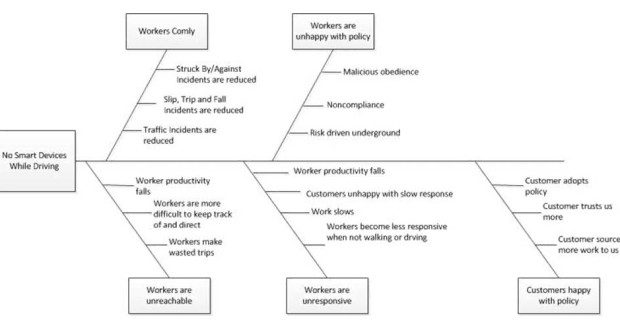Safety in the Digital Age: Regulating Worker Use of Distracting Devices
The dangers of distraction while working have garnered a great deal of attention. Distraction increases the risk of injury, but taking the appropriate steps to reduce distraction are neither easy nor simple. Much thought must be given to the consequences, fairness, and practicality of any regulations aimed at reducing the risks associated with worker distraction.
Posted: January 23, 2014
Here is an important emerging issue: the regulation of employees that use distracting devices. Restricting the use of certain mobile technology in the workplace isn’t quite as simple as it seems at first blush, but it needs to be done. According to the International Data Corporation (Framingham, MA), there are now over one billion smart devices in use, a number projected to rise above two billion by 2016 – an extremely high number of devices given the total world population.
SO WHAT’S THE PROBLEM?
Distraction is a key contributor to human error and can impair judgment to an extent comparable to alcohol. Distracted drivers are in an increasing number of traffic accidents. While most people are aware of the dangers of distracting devices, fewer recognize the dangers of merely walking while listening to music, checking email, or simply being distracted.
Furthermore, serious injuries and fatalities caused by being “struck by or against” something has been increasing and is likely to be an enforcement priority by OSHA. This adds to the already serious threat posed by slip, trip and fall injuries. In other words, unrestricted use of distracting devices represents a significant risk to worker safety.
THE CONNECTIVITY DICHOTOMY
Banning distracting devices is the kind of knee-jerk reaction we’ve come to know and love from safety professionals, but it isn’t feasible or even advisable. Thousands of useful apps are now available for tablets and phones that increase workplace productivity and even safety. And these aren’t the only distracting devices, because workers can be just as easily distracted by radios, bar code readers, or practically any portable device, irrespective of its purpose.
Because time is increasingly money, the rapid transfer of information from individuals in the field to key decision makers directly correlates to increased productivity and profitability. Reacting to distracting devices with a knee-jerk, one-size-fits-all regulation not only hamstrings innovation and continual improvement efforts, it also reinforces the image of the safety professional as the out-of-touch theorist, self-righteous obstructionist, or clueless goofball.
The benefits of these devices are real, but so too are the dangers their use poses. “The human toll is tragic,” notes David Michaels, PhD, MPH, the assistant secretary for occupational safety and health at the U.S. Department of Labor. “DOT reports that in 2009, more than 5,400 people died in crashes linked to distraction and thousands more were injured. Texting while driving has become such a prominent hazard that 30 states now ban text messaging for all drivers.”
Michaels acknowledges the advantages of new and useful technology, but questions the value proposition associated with the use of these devices while driving. “There’s no question that new communications technologies are helping business work smarter and faster,” he says. “But getting work done faster does not justify the dramatically increased risk of injury and death that comes with texting while driving.”
While Michaels is certainly correct in condemning texting while driving, this practice is only the latest and most widely publicized dangers of distracting devices. Texting is not the only distracting device-based activity that happens while driving. Commercial drivers routinely use laptop computers, tablets, global positioning systems, music players (from the in-dash radio to elaborate sound systems and accessories) and a host of emerging devices while driving.
Studies confirm that distraction from devices is significantly more dangerous than distractions from eating in the car or having a conversation with a passenger. Over 95 percent of communication between two people is nonverbal and takes less brain power to process than a conversation between two people via a phone or radio.
A growing number of fatalities are arising from distracted pedestrians who are so absorbed in the use of a distracting device they become afflicted with inattention blindness, i.e., they miss unusual events like a forklift barreling down on them or a delivery truck rounding a corner and step into the path of certain death. While the primary concern of OSHA has been distracted drivers, the rise is pedestrian deaths is sure to shift this dynamic, and change is likely to come sooner than later.
ARGUMENTS FOR BANNING DISTRACTING DEVICES
Arguments for banning are clear and make a lot of sense. Their distraction can be dangerous, but so are a lot of things that we judge to be worth the risk. There is consensus that many driving and traffic-related accidents – which rank as a leading cause of workplace fatalities – could have been prevented by less distraction of drivers.
Employee Liability versus Corporate Liability
Apart from the obvious risk of a worker death, companies are growing concerned of the tricky liability associated with driver distraction. Will a company with no policy banning distracting devices be judged as culpable if one of their employees kills someone while driving while distracted? The law increasingly views policies that are widely disregarded, or simply on the books with no expectation of compliance, as akin to no policy at all. Simply put, having a vague, all-inclusive “thou shalt not . . .” policy may not safeguard your organization from liability.
The Invisible Gorilla
In their book The Invisible Gorilla: How Our Intuitions Deceive Us, Christopher Chabris and Daniel Simons recount their findings from the seminal “Invisible Gorilla” study where they produced a video tape of two teams playing basketball, one team wearing white shirts and the other wearing black. Subjects were told to concentrate only on the players wearing white shirts, ignore the players wearing black shirts, and count the passes the white team made. In the middle of the video, a student wearing a full gorilla suit enters the play, walks in front of the camera, thumps her chest and leaves.
The gorilla was on screen over nine seconds, yet 50 percent of the test subjects failed to see it. This study has been validated and replicated many times, with profound implications for the safety of a distracted workforce that conclude that most people are likely to miss unexpected events when they are concentrating on another task. To see a shorten demo of the video in the experiment click here.
Slip, Trip & Fall and Struck By/Against Injuries
Injuries caused by slips, trips, falls and struck by/against are rising, with a strong correllation between being distracted and being injured (or injurying another). How often have you investigated an injury only to have the injured party shrug and say, “I just wasn’t thinking?” In effect, the injured party is saying that they were distracted by thinking about something else. This isn’t the occasion for blaming or judging. The fact is, human beings have a relatively short attention span and distraction often plays a role in worker injuries.













